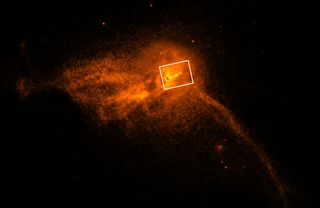The jets emanating from a famous black hole are cruising along at about 99% the speed of light, according to new observations.
Researchers spotted the speedy jets emanating from a black hole in the galaxy Messier 87 (M87) — the same black hole that was imaged directly for the first time last year.
NASA's Chandra X-Ray Observatory imaged knots of material speeding away from the accretion disk, where gas, dust and other material swirl around the black hole. Some of the material falls into the black hole, and some is redirected away into jets of material that follow magnetic field lines.
Video: Black Hole Blasting Particles Away at Near Light Speed
Related: 1st Photo of a Black Hole Named Science Breakthrough of 2019
Related: 1st Photo of a Black Hole Named Science Breakthrough of 2019

A first look at the X-ray data appears to show particles in the jets traveling faster than the speed of light, but that is due to a phenomenon known as superluminal motion. "We haven't broken physics," lead author Brad Snios, a postdoctoral researcher at the Harvard-Smithsonian Center for Astrophysics (CfA), said in a statement.
Superluminal motion happens when objects are moving at almost the speed of light while traveling along a direction close to the line of sight between Earth and the object. "The jet travels almost as quickly towards us as the light it generates, giving the illusion that the jet's motion is much more rapid than the speed of light," CfA officials explained in the statement.
The apparent motion seen by Chandra shows two X-ray knots within the jet moving at 6.3 times the speed of light for the knot closer to the black hole, and 2.4 times the speed of light for the knot farther away. (The speed of light is 186,282 miles per second, or 299,792 kilometers per second). The X-ray measurements mark the first time that astronomers could map the speed of the motion, which was previously observed in radio and optical wavelengths.
The faster-moving knot also faded by more than 70% between 2012 and 2017, the two times that Chandra turned its attention to M87. Researchers attribute the fading to particles losing energy through producing radiation as they spiral around the black hole's magnetic field.

Chandra's information provides a different view of the black hole than the Event Horizon Telescope that imaged M87. The EHT looked at M87 over six days in April 2017, while Chandra's examinations of the jet look at material thrown out of the black hole up to thousands of years ago.
The results were presented at the recent meeting of the American Astronomical Society in Hawaii, and are also published in The Astrophysical Journal.



No comments:
Post a Comment